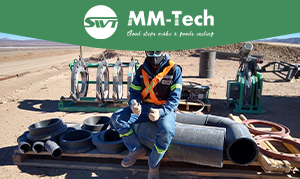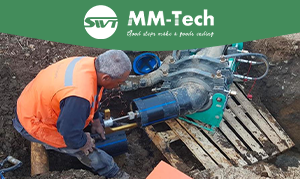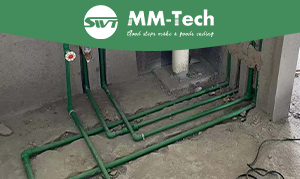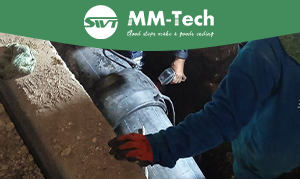Putting in 10-inch HDPE pipes needs careful work for smooth joins. An HDPE welding machine makes this easier by joining pipe ends perfectly. Good welding stops leaks and makes the pipes stronger. It helps the pipes handle pressure and weather, lasting longer without needing many repairs.
Key Takeaways
Wipe the ends of HDPE pipes clean before welding. This stops weak spots and makes strong, lasting connections.
Line up the pipe ends correctly with marks and clamps. Good alignment is key for strong, leak-free welds.
Watch the heating and cooling steps closely. Keep the right heat and let it cool enough for solid, smooth joints.
Cleaning and Getting HDPE Pipe Ends Ready
Why Cleaning is Important for Strong Joints
Cleaning HDPE pipe ends is key for strong, smooth joints. Dirt or grease can weaken the weld and make pipes less durable. Clean surfaces stop dirt from getting stuck in the joint. This lowers the chance of the joint failing.
Studies show dirty joints make weaker HDPE pipe connections. Welded pipes break easier than clean, unwelded ones. This proves cleaning is very important before welding.
Steps to Smooth Pipe Edges
Smoothing pipe edges helps them fit well for welding. Follow these steps:
Use a tool to remove sharp edges from pipe ends.
Use another tool to make a slanted edge for better alignment.
Check the pipe ends to make sure they are smooth.
These steps make the pipe ends clean and ready for welding.
Marking Pipes for Proper Alignment
Marking pipe ends helps align them during welding. Use a marker to draw lines on the pipe ends. These lines guide you to place the pipes correctly in the welding machine.
Evidence | What It Means |
|---|---|
Clean Surfaces Needed | Remove dirt to avoid weak welds. |
Surface Prep Importance | |
Fusion Needs | Clean, aligned pipes with the right heat and pressure. |
Cleaning and preparing pipe ends helps create strong, long-lasting joints.
Aligning and Clamping with MM-Tech Butt Fusion Machine
Positioning Pipes for Proper Alignment
Getting the pipes straight is key for a good weld. Place the pipe ends into the MM-Tech Butt Fusion Machine clamps. Make sure the pipes are straight and even. If they are crooked, the weld may be weak and break easily.
Use the alignment marks you made earlier to help. These marks show where the pipes should meet perfectly. The MM-Tech Butt Fusion Machine holds the pipes tightly so they don’t move while welding.
Research shows alignment is very important. When pipes are lined up right, the weld is smooth and strong. This makes the joint last longer without gaps or bumps.
Securing Pipes in the Butt Fusion Machine Clamps
After aligning the pipes, lock them tightly in the clamps. The clamps are made to hold the pipes without harming them. Tighten the clamps evenly to keep the pipes straight. This step keeps the pipes steady during welding.
The MM-Tech Butt Fusion Machine uses a hydraulic system to press the pipes together. This pressure helps create a strong bond. Check the clamps again to make sure the pipes are secure before moving on.
By doing these steps, you prepare for a perfect weld. Straight and secure pipes let the machine work properly for a strong connection.
Fusion Welding Process for HDPE Pipes
Heating Pipe Ends to the Correct Temperature
Heating pipe ends is an important step in welding. Make sure the pipe ends get hot enough for a strong bond. Place the pipe ends on the heating plate of the MM-Tech Butt Fusion Machine. The heating plate keeps the temperature steady, melting the pipe ends evenly.
Look for a melted bead forming on the pipe ends. This bead shows the material is soft enough to join. Don’t overheat, as it can damage the material and weaken the joint. Underheating can cause weak bonds and possible leaks.
Tip: Use the machine’s temperature control to check and adjust heat for better results.
Joining and Pressing for a Seamless Bond
After heating, take the pipe ends off the heating plate. Quickly press them together using the MM-Tech Butt Fusion Machine. The machine applies pressure to join the melted surfaces smoothly. Align the pipes properly to avoid gaps or uneven joints.
Pressing creates a strong bond, as tough as the original pipe. Research shows butt fusion and electrofusion are great for seamless joints. Butt fusion melts and presses pipe ends together. Electrofusion uses special fittings with heating parts to fuse pipes. Both methods make strong, leak-proof, and durable joints.
Note: Keep steady pressure during pressing to avoid weak spots or uneven bonds.
Monitoring Heat Soak Time for Strong Welds
Heat soak time is key to good welding. After placing the pipe ends on the heating plate, let them melt evenly. The MM-Tech Butt Fusion Machine helps you time this step perfectly.
Keep the pipe ends on the heating plate for the right amount of time. This ensures the whole surface gets hot enough to fuse. Once the time is up, quickly remove the pipe ends and press them together.
Studies show proper heat soak time makes welds stronger and more durable. It also prevents weak joints and incomplete fusion.
By following these steps, you can weld HDPE pipes like a pro. Heating, pressing, and timing correctly will create strong, seamless joints that last.
Cooling and Checking Strong HDPE Pipe Welds
Letting the Weld Cool Without Touching
After welding, let the joint cool without touching it. This step keeps the connection strong and secure. Moving the pipe during cooling can weaken the bond.
Cooling helps the melted material harden evenly. This creates a strong and smooth joint. The cooling time depends on the pipe size and temperature around it. Bigger pipes or hotter areas may need more time to cool properly.
Why cooling without touching is important:
It makes the joint strong to handle high pressure.
It stops weak spots caused by early movement.
It keeps the pipe straight and in place.
By letting the weld cool undisturbed, you make it stronger and longer-lasting.
Checking Welds for Strength and Quality
Once the weld cools, check it to ensure it is strong. A good HDPE pipe weld should look smooth and even. There should be no gaps or rough spots. A neat bead around the joint shows proper fusion.
Use rules from experts to check the weld’s strength and quality. For example:
What It Checks | |
|---|---|
D3035 – 15 | Pressure ratings for plastic pipes in different uses. |
D3350 – 14 | Identifies materials for plastic pipes and fittings. |
D2513 – 16 | Tests for burst strength and chemical resistance. |
D2837 – 13 | Finds design strength for plastic pipes. |
These rules help confirm the joint is safe and works well. Regular checks and following guidelines make HDPE pipe installations more reliable.
Overview of HDPE Welding Machines and Tools
Types of HDPE Welding Machines by MM-Tech
MM-Tech makes many HDPE welding machines for different projects. These machines use advanced technology for accurate and strong welds. The butt fusion machine is very popular. It uses hydraulic pressure to join pipe ends tightly. This machine works well for big jobs like pipelines.
For smaller spaces, the electrofusion machine is a good option. It is small and has built-in controls, making it easy to use. It works with pipes of many sizes. Both machines have automatic systems to reduce mistakes. This makes MM-Tech machines dependable for welding HDPE pipes.
MM-Tech also designs portable tools for easy use. Their lightweight machines save energy and are great for on-site repairs. Whether at a construction site or faraway location, MM-Tech machines give you the performance you need.
Essential Tools for HDPE Pipe Welding
You need the right tools for welding HDPE pipes. Each tool has a special job in the process. Here is a table showing the tools and their uses:
Tool | Key Features | Purpose |
|---|---|---|
Butt Fusion Machine | Clamps pipes, controls pressure and heat | Joins pipe ends into a smooth connection |
Electrofusion Machine | Small size, works with many pipe sizes | Welds pipes in tight spaces |
Heater Plate | Non-stick, heats between 400°F and 450°F | Melts pipe ends evenly |
Facing Tool | Sharp blades for trimming pipe edges | Prepares pipes for welding |
Alignment Clamps | Strong and adjustable to hold pipes steady | Keeps pipes straight during welding |
Control Unit | Digital screen, controls welding steps | Manages the fusion process |
These tools make welding easier and more accurate. For example, the heater plate melts pipe ends evenly, and clamps keep pipes steady. Using strong materials makes these tools last longer. With the right tools, you can make strong, leak-proof pipe joints that last a long time.
Tips for Making Strong HDPE Pipe Welds
Keeping Pipes Aligned Correctly
Aligning pipe ends properly is very important for strong welds. If pipes are not aligned, joints can be weak and may leak. To keep pipes aligned:
Use clamps to hold the pipes firmly in place.
Check the marks you made earlier to ensure proper positioning.
Look at the pipe ends to confirm they meet evenly without gaps.
Proper alignment makes the weld stronger and helps the pipeline work better.
Research shows these key points:
Aligned pipes create better-quality welds.
Strong welds make pipelines last longer and work well.
By following these tips, you can make joints that handle pressure and tough conditions.
Keeping Heat and Pressure Steady
Steady heat and pressure are needed for good welds. Uneven heat or pressure can weaken the joint. To keep things steady:
Set the heating plate to the right temperature using the machine.
Watch the heat soak time to melt the pipe ends evenly.
Apply even pressure when joining the pipes for a smooth bond.
Factor | How It Affects Welds |
|---|---|
Welding Temperature | Too much heat makes brittle seams; too little causes weak welds. |
Welding Pressure | Uneven pressure can cause weak spots; proper alignment is key. |
Dwell Time (Speed) | Slow cooling can harm the material; fast cooling makes stronger welds. |
Tip: Keep steady pressure during welding to make a strong connection.
Steady heat and pressure help create strong, long-lasting welds.
Avoiding Common Welding Errors
Avoiding mistakes during welding saves time and prevents problems later. Common errors include uneven heating, bad alignment, and ignoring instructions. To avoid these:
Check all settings before starting.
Make sure the heating plate is clean.
Follow the recommended heat soak time and pressure levels.
Problem Found | How to Fix It |
|---|---|
Weld area too hard, causing cracks. | Adjust settings to lower hardness in the weld. |
Material became brittle, leading to cracks. | Use better materials and control the process. |
Ignored manufacturer instructions. | Follow all guidelines for better results. |
Note: Check your tools often and follow instructions to avoid problems and get good results.
By fixing these mistakes, you can make your HDPE pipe welding projects more successful and reliable.
An HDPE welding machine helps make smooth pipe connections. Clean the pipes, line them up, and check each joint carefully. Good preparation and steady welding make strong, lasting bonds. MM-Tech’s Butt Fusion Machine is a great tool for this job. It works accurately and efficiently for all your pipe welding tasks.
FAQ
1. What is the best temperature for welding HDPE pipes?
The best temperature for welding HDPE pipes is 400°F to 450°F. Use the MM-Tech machine’s controls to keep the heat steady for strong welds.
Tip: Always check the heating plate to ensure the temperature is correct before starting.
2. How long should you wait before checking the weld?
Wait 5-10 minutes for the weld to cool completely. The cooling time depends on the pipe size and surrounding temperature. Do not move the pipe during this time.
Pipe Size | Cooling Time |
|---|---|
Small | 5 minutes |
Large | 10 minutes |
3. Can MM-Tech machines weld pipes of different sizes?
Yes, MM-Tech machines can weld pipes from 355mm to 1200mm. Use the adjustable clamps and reducers to align pipes properly during welding.
Note: Always check the machine’s details to make sure it fits your pipe size.









